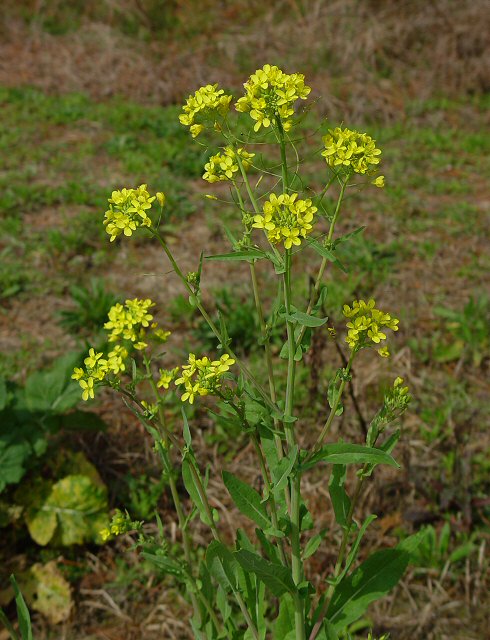Brassica napus L.
Rutabaga

Introduced
CC = *
CW = 5
MOC = 10
© DETenaglia
Brassica napus L.Rutabaga | |
 |
Introduced CC = * CW = 5 MOC = 10 |
© DETenaglia |
|
Family - Brassicaceae Habit - Annual or biennial forb, from often fleshy and expanded taproot. Stems - Erect, to 1.5 m, sometimes branching, often reddish below, glabrous, glaucous.
Leaves - Basal and lower leaves often absent at flowering, 5-25 cm long, irregularly pinnately divided or lobed, petiolate but sometimes with rounded auricles at the base, mostly obovate in outline. Stem leaves alternate, glabrous, glaucous, progressively reduced toward the tip, the uppermost 2-5 cm long, sessile, the bases clasping and with rounded auricles of tissue, linear to narrowly oblanceolate in outline, irregularly toothed or shallowly lobed.
Inflorescences - Terminal racemes, compact in flower, elongating in fruit. Pedicels of flowers 5-6 mm long, elongating in fruit to 1.5 cm, 1 mm in diameter, not subtended by bracts.
Flowers - Sepals 4, 6-10 mm long, yellow, glabrous, linear, spreading to erect. Petals 4, 1.0-1.6 cm long, 4-5 mm broad at apex, yellow, glabrous, to 1cm long, clawed. Stamens 6, erect. Longer 4 stamens with filaments to 4.5 mm, white, glabrous. Shorter stamens with filaments to 2 mm. Anthers yellow, 2 mm long. Ovary 4.5 mm long, slightly flattened, glabrous. Style 2 mm long, persistent in fruit as beak.
Fruits - 5.0-9.5 cm long, more than 10 times longer than wide, ascending or spreading, terete or nearly so, the slender, tapered beak 9-15 mm long. Seeds 1 row per locule, 24-40 per fruit, globose, 1.5-2.5 mm in diameter.
Flowering - April - September. Habitat - Cultivated and escaped to waste places, roadsides, railroads. Origin - Native to Europe. Lookalikes - Other members of the Brassica genus. In particular, confident differentiation from Brassica rapa can be very difficult. Other info. - This is the commonly cultivated rutabaga long used by humans as a root and storage vegetable. The plant is actually quite nice to look at. Its occurrence in Missouri is sporadic, uncommon, and waiflike, except where cultivated. Escapes do not seem to persist long in the wild. Identifying features include glabrous and glaucous herbage, leaves with clasping bases, and relatively large, bright yellow flowers. Photographs taken off Hwy 29, Pike County, AL., 2-26-05; also near Labadie, Franklin County, MO, 4-21-016, and at Silver Mines Recreation Area, Madison County, MO, 4-8-2019 (SRTurner). |